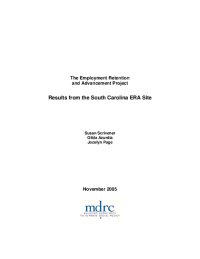Results from the South Carolina Site in the Employment Retention and Advancement Project
Although much is known about how to help welfare recipients find jobs, little is known about how to help them and other low-wage workers keep jobs or advance in the labor market. This report presents information on the effectiveness of a program in South Carolina that aimed to help former welfare recipients obtain jobs, work more steadily, and move up in the labor market. The program was run as part of the Employment Retention and Advancement (ERA) project, which is testing 15 programs across the country. The ERA project was conceived by the U.S. Department of Health and Human Services (HHS); it is being conducted by MDRC under contract to HHS, with additional funding from the U.S. Department of Labor (DOL).
South Carolina's ERA program, Moving Up, which operated between September 2001 and April 2005 in six rural counties, attempted to contact and assist individuals who had left welfare for any reason between October 1997 and December 2000. Typically, nonworking participants received help finding a job, and working participants received help staying in their job or moving up. The core of Moving Up was one-on-one case management, with staff aiming to provide or connect participants with a range of services, including job search assistance, short-term vocational training, and support services. The program also provided modest financial incentives to encourage and reward program engagement and employment achievements.
Moving Up is being evaluated using a random assignment research design, whereby eligible individuals were assigned, through a lottery-like process, either to a program group, whose members were recruited for the ERA program, or to a control group, whose members were not recruited or eligible for ERA services but who could use other services in the community. The program's effects were estimated by comparing how the two groups fared over time.
Key Findings
- Engaging individuals in Moving Up was challenging. After extensive outreach efforts, staff located about three-fourths of the program group — most of whom had been off welfare for several years when they entered the study. Even then, staff had to market the program to individuals who were not required to take part in it, many of whom did not want or need services. Just under half of the program group were engaged in ERA services during the year after they entered the study, many of them not very intensively. Compared with results for the control group, Moving Up increased participation in some employment-related services, such as vocational training, but only modestly.
- Overall, Moving Up had little effect on employment rates, earnings, employment retention, or advancement. During the year after entering the study, members of the program and control groups had similar employment outcomes. Results for early enrollees in the study, whose follow-up data cover two years, suggest that program effects will not emerge during the second year after study entry or later. Overall, Moving Up also did not affect welfare or food stamp receipt or income. The program, however, had positive effects on employment for three subgroups of sample members: those who had become unemployed shortly before entering the study, those who had left welfare less than two and a half years before entering the study, and those who had left welfare because of a sanction or the state's time limit on benefit receipt. The effects for the recently unemployed subgroup are the largest but are less certain than the other results because the sample size for the group is small — only about 9 percent of the sample analyzed for this report, or 249 individuals. Finally, one county's program produced positive effects on employment, but the other five did not.
These results are not the final word on South Carolina's ERA program, as MDRC will continue to track employment outcomes for the study's participants. The findings do, however, illustrate the persistent challenge of encouraging participation in postemployment services and making a difference in labor market outcomes for welfare leavers. Many of the individuals in the study remain poor and in need of supports.






